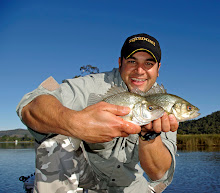

There's no gold medal for realising i just LOVE soft plastic fishing. It has totally revolutionised my fishing. Dont get me wrong. I fish other techniques too but none quite have the possibilities and versatility of soft lures. Take for instance the ablility to work the whole water column, re-size heads to suits current, depth, species, line class and catsing distance, or perhaps change plastic to suit all of those same conditions!!!
The versatility is astounding. This can be a drawback for a novice as knowing where to start can be a little confusing. The tackle stores dont help either. Walls are lined with so many brands, colours, sizes and patterns that sometimes for a greenhorn its easier to buy that old packet of pillies than to try and de-code the soft plastic puzzle.
All that aside, why are soft plastics so successful? A million new soft plastic anglers can't be wrong about em. They really have entrenched themselves as a must-know technique to catch fish. So why are they so deadly??? What is the catalyst? Can anyone pick up a rod and be successful???
First of all soft plastic fishing, like any other form of fishing, is subject to the current conditions. You cant catch fish that simply are not there. No use trying to catch a whiting in winter for example. It can happen but the odds are stacked against you. Knowing where to fish and what fish are available will assist in applying a gameplan. Bait fishos transitioning to softies will find the transition fairly easy i would assume. All the same priciples apply to baitfishing as plastix, fish the same gutters, structure, eddies etc. Also baitfishos will have an understanding what food fish eat. These items can be replicated using softies..
But knowing fish behaviour and diet is only part of the success. The most important aspect of why softies are so successful revolves around the method or delivery of such lures. By this i mean plastix fishing is sedentary. Its an active form of angling that requires in the most part for the angler to be active and cover a heap of water. In a given session you might cover an area 20kms long. While you wont cover all that with a fine tooth comb, you will pick out the hotspots in that area and cover those more thoroughly.
A bait fishing, apart from drifting, will anchor up somewhere and wait for the fish to pass thier boat. The use of berley can assist in drawing the fish to them, but really are subject to fish picking up the berley trail for success. The effective water they are fishing is a radius of perhaps 20m around the boat. Now you cant really compare 20m to 20kms of water coverage.
The whole premise of why plastix fishing is so successful is cause the angler hunts the fish, covers a stack of water and presents an offering close to the natural food item of the fish. Sure its not a live bait, or not even a real food item, but its all about the deception. This usually takes some getting used to. Rod manipulation is very important and will develop over time. Once fish are located, stay with em.
For the novice, just drift. Use drifting as your means to cover water and eventually you come across fish. The other benefit of drifting is that your lures are continually in the strikezone unlike cast-and-retrieve where you cast, wait for the lure to touch bottom, then commence the retrieve to the boat. While i prefer cast-and-retrieve cause its more active, and if done right can actually cover more water than drifting, it does require some ability to know where your lure is and deal with the slack line that happens on a retrieve. The biggest issue i see with novices is a lack of patience, not allowing the lure to sink to the bottom. Thus the retrieve is done mid-water, and usually no fish.
Due to being active we come across alot more fish. Our catch-rates on plastics are far exceeding those on bait. Im not trying to say lures catch more fish than bait but moving your lure, or bait for that matter, past the nose of as many fish as possible can only increase your catch rates. Sitting back and waiting for fish to come past your boat is a thing of the past. You've gotta go to the fish.
So to reiterate, be active. Its the biggest factor for success. Move around, try different spots, different depths, different structure. Find the fish and then try and deliver what the fish may want to eat. Its a simple philosophy...but sometimes alot harder to put into practise.

No comments:
Post a Comment